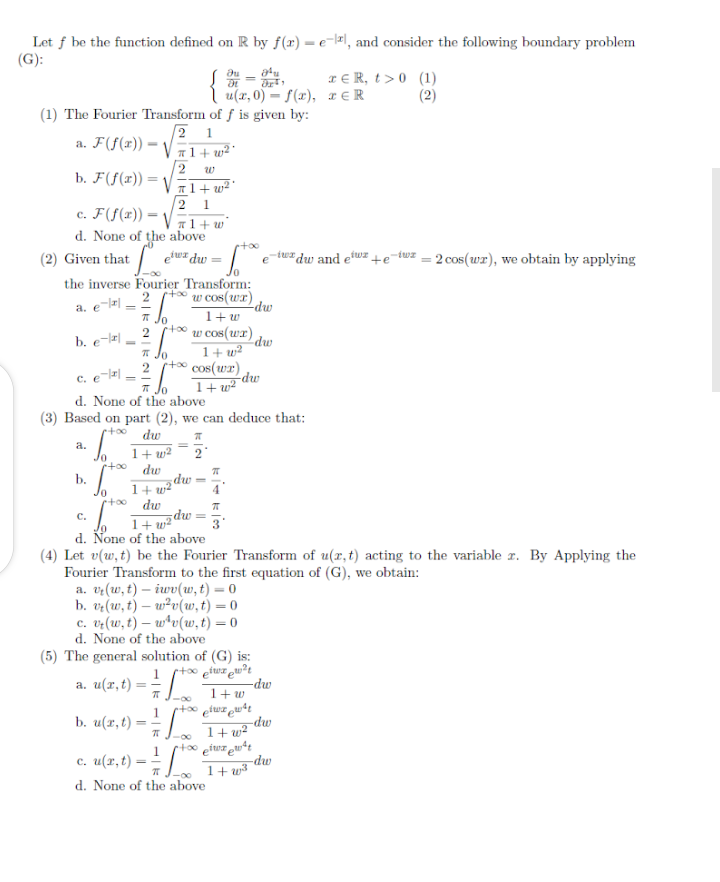d. None of the above (3) Based on part (2), we can deduce that: dw a. 1+ w2 Jo dw dw 1+ w? dw dw 1+ w? d. None of the above b. C.
d. None of the above (3) Based on part (2), we can deduce that: dw a. 1+ w2 Jo dw dw 1+ w? dw dw 1+ w? d. None of the above b. C.
Advanced Engineering Mathematics
10th Edition
ISBN:9780470458365
Author:Erwin Kreyszig
Publisher:Erwin Kreyszig
Chapter2: Second-order Linear Odes
Section: Chapter Questions
Problem 1RQ
Related questions
Question
fourier transform
part 3

Transcribed Image Text:Let f be the function defined on R by f(x) = e-lxl, and consider the following boundary problem
(G):
TE R, t> 0 (1)
I u(x, 0) = S(x), r€R (2)
(1) The Fourier Transform of f is given by:
2 1
11+ w² '
a. F(f(x)) = V
w
b. F(f(1)) = V
+ w² *
1
c. F(f(x)) =
d. None of the above
%3!
T1+ w
+oo
(2) Given that
iuz dw =
-tuz dw and ew
- 2 cos (wr), we obtain by applying
+e
the inverse Fourier Transform:
w cos(wr) dw
a. erl =
1+w
Jo
rtoo
2
w cos(wr)
1+ w²
t∞ cos(wr)
1+ w²
b. e-|
dw
T Jo
2
-dw
* Jo
d. None of the above
(3) Based on part (2), we can deduce that:
rtoo
dw
a.
1+ w²
dw
Jo
mp
1+ w²'
rtoo dw
b.
dw =
1+ w2
C.
d. None of the above
(4) Let v(w,t) be the Fourier Transform of u(r, t) acting to the variable r. By Applying the
Fourier Transform to the first equation of (G), we obtain:
a. vr(w,t) – iwv(w, t) = 0
b. vz(w, t) – w²v(uw,t) = 0
c. vr(w,t) – w*v(w, t) = 0
d. None of the above
(5) The general solution of (G) is:
rtoo ptwa ewt
-dw
1+ w
1
a. u(x, t) =- /
%3D
b. u(r,t) =
-dw
1+ w?
rto0 piwa put
-dw
1+ w3
-00
c. u(x, t)
d. None of the above
-00
Expert Solution
This question has been solved!
Explore an expertly crafted, step-by-step solution for a thorough understanding of key concepts.
Step by step
Solved in 2 steps with 2 images

Recommended textbooks for you

Advanced Engineering Mathematics
Advanced Math
ISBN:
9780470458365
Author:
Erwin Kreyszig
Publisher:
Wiley, John & Sons, Incorporated

Numerical Methods for Engineers
Advanced Math
ISBN:
9780073397924
Author:
Steven C. Chapra Dr., Raymond P. Canale
Publisher:
McGraw-Hill Education

Introductory Mathematics for Engineering Applicat…
Advanced Math
ISBN:
9781118141809
Author:
Nathan Klingbeil
Publisher:
WILEY

Advanced Engineering Mathematics
Advanced Math
ISBN:
9780470458365
Author:
Erwin Kreyszig
Publisher:
Wiley, John & Sons, Incorporated

Numerical Methods for Engineers
Advanced Math
ISBN:
9780073397924
Author:
Steven C. Chapra Dr., Raymond P. Canale
Publisher:
McGraw-Hill Education

Introductory Mathematics for Engineering Applicat…
Advanced Math
ISBN:
9781118141809
Author:
Nathan Klingbeil
Publisher:
WILEY

Mathematics For Machine Technology
Advanced Math
ISBN:
9781337798310
Author:
Peterson, John.
Publisher:
Cengage Learning,

